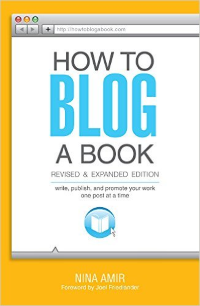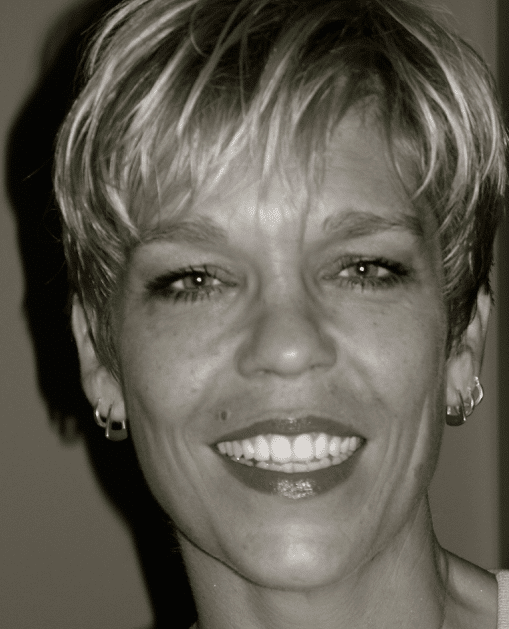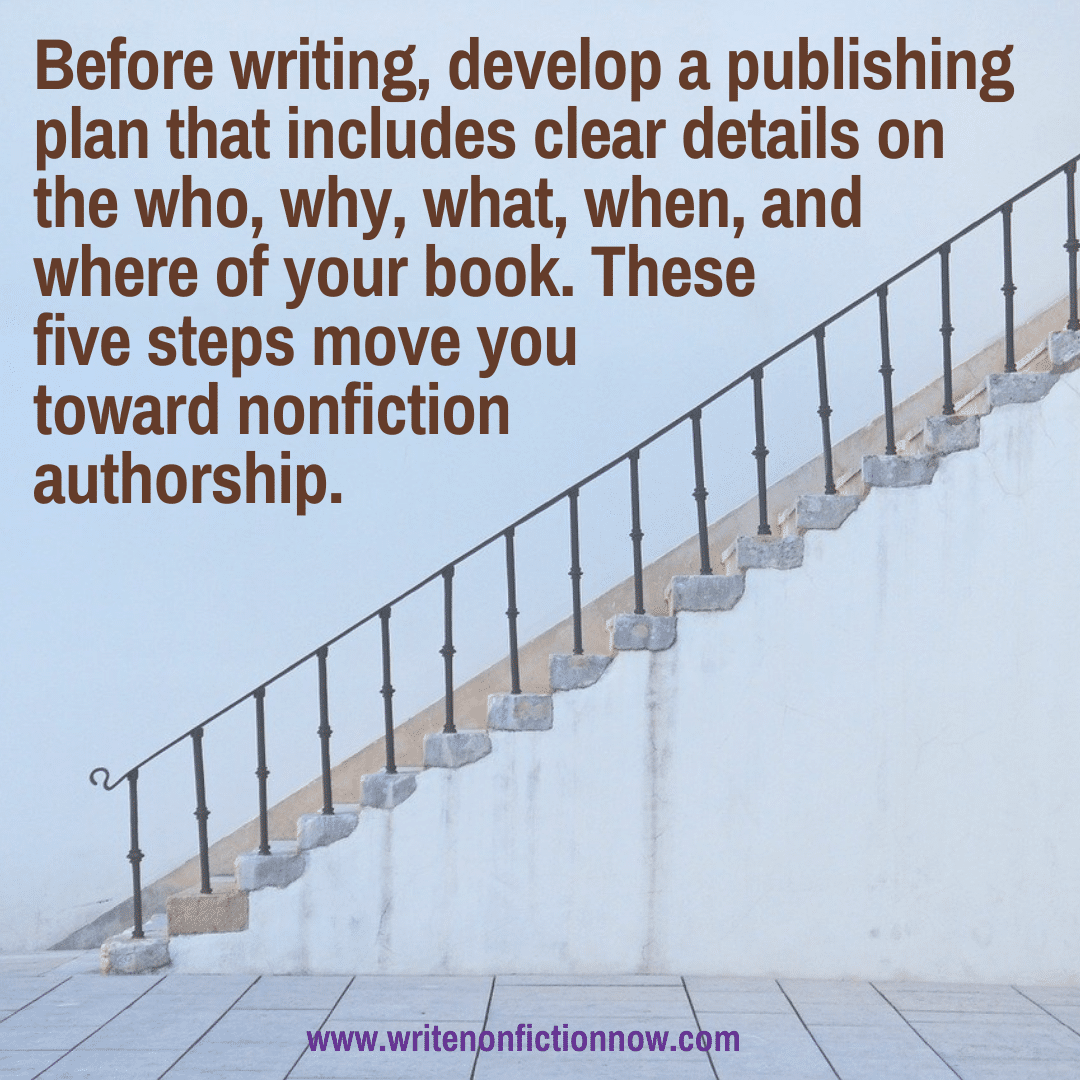No matter the reason you decided to write a book, your success as a nonfiction author depends largely on planning. Therefore, it’s essential to understand the steps required to become an author before you begin writing.
In fact, authorship requires five steps. And you want to develop a corresponding publishing plan that includes clear details on the who, why, what, when, and where of writing your book.
A summary of each of these five steps follows, and the plan you create will take you from planning your project to marketing your published book.
Who: Your Audience
Before you commit the first words to a page, it’s essential to define your target audience. Who are you writing for? This constitutes step one.
When I wrote my first book, I made the mistake of being so enthusiastic about my topic that I forgot I wasn’t writing the book for myself. As a result, I wasted time writing content I later discarded because I hadn’t taken the time to define who I was writing for.
Plus, your book won’t be a good fit for everyone. That’s why it’s essential to narrow your target audiences. As a result, you’ll find it easier to write and market the book.
So before you go full steam ahead on your first draft, make sure you’ve clearly identified your ideal reader. You can use the following resources to help you define your audience:
- Who Is Your Target Audience And What Do Your Readers Want?
- Finding And Writing For Your (Real) Audience
- How To Define And Describe Your Readership: A Confusing Issue For Nonfiction Book Proposals
- Identifying your Audience: Don’t spin your wheels with those who aren’t interested in what you have to say
Why: Your Hook
Once you’ve defined your target audience and the topics you want to write, go one step further and incentivize people to read what you’ve written. People read books because of their benefits or what they promise to deliver. When you write nonfiction, it’s a straightforward task to define that intent—simply focus on your reader’s pain points.
Then, promise to relieve their discomfort. Connect with your readers by writing about their struggles or what they’re looking for or striving to understand.
Here are some resources to help you discover your hook:
- Read How To Target Your Audience By Answering The “Why” For Them In Everything You Do
- The Fastest Way For Writers To Share A Message And Make A Difference
- How To Write A Stellar Hook For Your Nonfiction Book
- How To Create A Book Hook
What: Your Project
 By this point, you’ve figured out who you’re writing for and why they need to read your book. Now it’s time to define your project’s format.
By this point, you’ve figured out who you’re writing for and why they need to read your book. Now it’s time to define your project’s format.
If the thought of writing a fifty to seventy-five thousand-word book feels overwhelming, set smaller goals. Then, take one of these approaches:
- The Piecemeal Approach: write your content using a series of blog posts to combine them into a full-length book. This technique is called blogging a book, and you can learn about this process over on our sister blog, How to Blog a Book.
- The Short Book Approach: these books are less than 100 pages. If you self-publish on Amazon KDP, there’s even a dedicated page showcasing short reads. And readers can filter by the time it would take to read a book. They estimate a book that’s 65-100 pages long will take approximately two hours to read. (If only it took that long to write!) Writing a short book helps to keep you focused on your topic and audience and can prevent you from veering off on content tangents. Writing a short book can seem more achievable, especially if it’s your first book. This approach has the added benefit of setting you up to write a series of books on related topics. To learn more about how to write a short book fast, click here.
Here are some additional resources to help you write a short book:
- How To Blog A Short Book To Build Expert Status
- 7 Reasons To Blog A Short Book
- A Short Book With Bonus Content Makes A Great First Product
If you’re ready to write a full-length book, though, prepare to completely immerse yourself in the project. If writing a book was only about writing the first draft, everyone would be doing it. Instead, writing a book involves planning, research, writing, self-editing, rewriting, and more rewriting. So, prepare yourself for an extended stream of effort. But once you finish a book project, you’ll have an immense feeling of satisfaction.
When: Your Schedule
When will you find time to write? This step in your planning process requires setting realistic expectations and scheduling writing time.
Will you be able to sit down at a moment’s notice and start writing your first draft, or will you have to engage in a free writing session to get in the right frame of mind? Will you need to plan a consistent block of time to write, or are you flexible enough to write “in the cracks of life“?
One of my most significant ah-ha moments while producing my first book was how difficult it was to get into the writing zone. I’m not one of those writers who can just sit down and write. My surroundings and mindset must be right, and I can’t have too many other tasks and commitments vying for my attention. If you are like me, you’ll want to put some thought into creating the time and space to write effectively.
Here are some resources to help you get writing and plan your time:
- Use A Planner To Develop A Successful Nonfiction Writing Career
- One Factor That Will Help You Write Consistently
- How A Production Schedule Helps You Develop A Lasting Writing Habit
- How To Schedule Your Writing Time
- 12 Expert Tips To Help You Write A Nonfiction Book Easily And Effectively
Where: Your Marketing
You are already prepared for this step—marketing your book. After all, you’ve already done some of the planning. Before you started writing, you identified your target audience and your book’s hook. Those two completed steps are foundational when it comes to planning your book marketing activities. When you know who you’re writing for and what benefit you provide to this person, you’ll find it easier to reach them with your message.
 It’s best to break your marketing plan into two separate segments. The first one involves methods to leverage your existing networks, and the second step expands your reach.
It’s best to break your marketing plan into two separate segments. The first one involves methods to leverage your existing networks, and the second step expands your reach.
Your existing networks include your website, mailing list, and social media networks. These three elements are used to promote and raise your business profile and connect with potential customers.
If you have this in place already, you can take these people along on your writing journey. Let them know about your book project as you’re writing it. This can provide valuable feedback from potential readers. However, it’s also a great way to start putting together beta readers as your book’s early adopters and a street team ready to help promote the book upon launch.
Once you’ve got into a rhythm of using your existing platforms, branch out into other activities. These may include guest blogging, optimizing your Amazon Author page, attracting the media’s attention, and taking part in online communities on Facebook or forums like Quora.
Here are some resources to help you get you market your book:
- If You Don’t Have A Mailing List Set Up Already, Read About These Six Popular Email Marketing Solutions
- Best Email Marketing Solutions For Bloggers And Authors in 2021
- Nonfiction Book Marketing For Introverts – Back To Basics
- Book Marketing: Social Media Tips For Introvert Authors
- Get Some Online And Offline Networking Tips And Inspiration
- How To Get Journalists From Your Amazon Author Page To Your Website
- 5 Book Marketing Dos And Don’ts To Help You Sell Your Book
Final Advice for Navigating the Stages
The key to writing a book is to develop a plan before you start your first draft. Also, consider how you will maintain your momentum. And keep one eye on the next step in the process, so you can see where you’re heading.
Break the planning, writing, and marketing steps into bite-size chunks of activity, so you can easily schedule them within your existing commitments. As a result, you’ll find it easier to complete your book and launch it successfully.
What’s getting in your way of writing your first book? Let me know, so I can help you over that hurdle. And please share this post with another writer.
About the Author
Jay Art ale abandoned her corporate career to become a digital nomad and full-time writer. She’s an avid blogger and a nonfiction author helping travel writers and travel bloggers achieve their self-publishing goals. Join her at Birds of a Feather Press where she shares tips, advice, and inspiration to writers with an independent spirit.
ale abandoned her corporate career to become a digital nomad and full-time writer. She’s an avid blogger and a nonfiction author helping travel writers and travel bloggers achieve their self-publishing goals. Join her at Birds of a Feather Press where she shares tips, advice, and inspiration to writers with an independent spirit.
 Do you want to learn more about becoming a nonfiction author? Check out the Nonfiction Writers’ University. Get the education and coaching to help you succeed as a nonfiction writer. Take advantage of monthly live group author coaching, and gain access to an extensive archive of educational resources, like interviews with experts, challenges, homework assignments, courses, and ebooks. If you’ve wanted one place to go for all your nonfiction writing and publishing needs, this is it. And if you’ve wished you could purchase Nina Amir’s best courses or hire her as your author coach, now you can…for a small monthly investment. Enjoy a 30-day trial membership for only $1.
Do you want to learn more about becoming a nonfiction author? Check out the Nonfiction Writers’ University. Get the education and coaching to help you succeed as a nonfiction writer. Take advantage of monthly live group author coaching, and gain access to an extensive archive of educational resources, like interviews with experts, challenges, homework assignments, courses, and ebooks. If you’ve wanted one place to go for all your nonfiction writing and publishing needs, this is it. And if you’ve wished you could purchase Nina Amir’s best courses or hire her as your author coach, now you can…for a small monthly investment. Enjoy a 30-day trial membership for only $1.
Photo courtesy of Anastasia Kolchedantseva.
